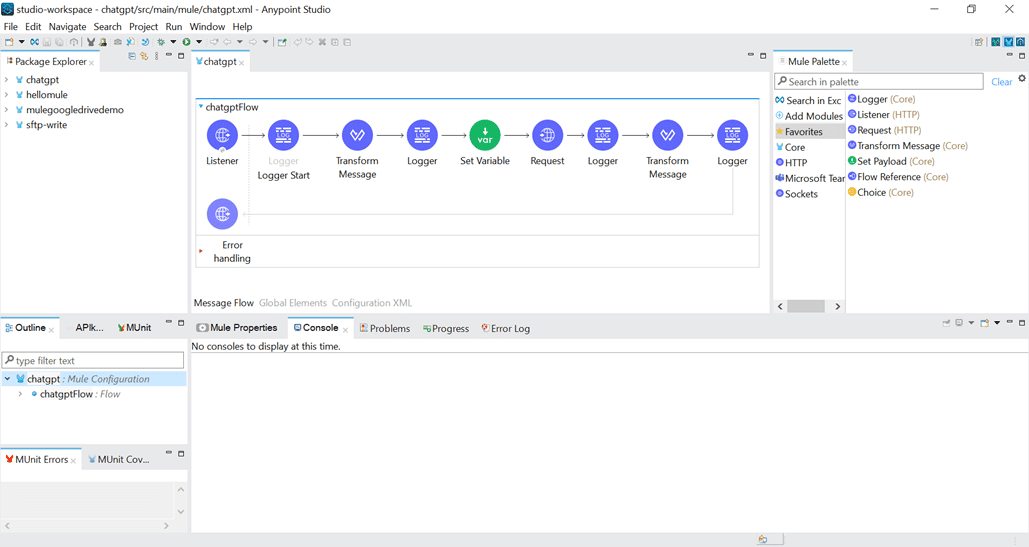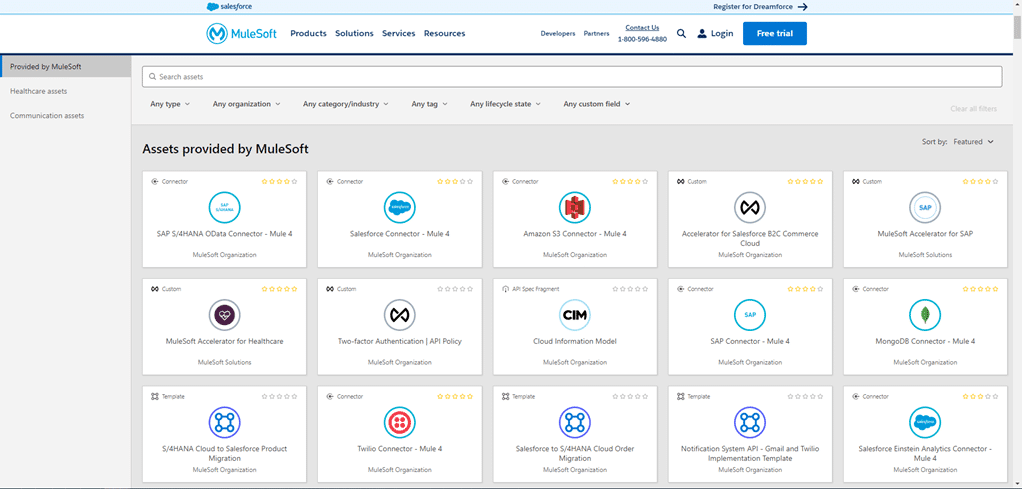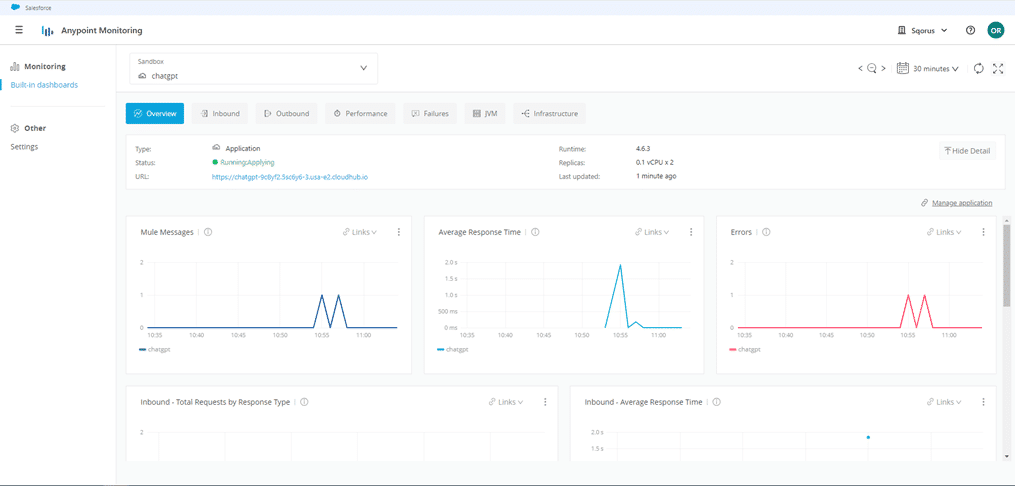Are you faced with the challenges of data integration?
Are dispersed sources, hybrid environments and growing interoperability and security requirements holding you back? Look no further! MuleSoft is the solution for you. This innovative tool offers a complete approach, from interface design to real-time monitoring. Find out in this article how MuleSoft can boost your data integration efficiency.
We all know that in today’s business landscape, data integration is crucial.
Data is often dispersed across a multitude of sources, making it essential to use effective tools to integrate it and make it usable.
Companies are facing increasing integration challenges, including diverse data sources, hybrid environments (cloud and on-premises), and ever-changing interoperability and security requirements. This article presents a complete solution for efficiently integrating your data.
What is MuleSoft?
MuleSoft is much more than just an integration platform.
It’s a complete solution that enables companies to quickly and easily connect their applications, data and devices, whether in the cloud, on-premise or in a hybrid environment.
This enables teams to focus on higher value-added tasks, boosting overall business efficiency.
At the heart of MuleSoft is Anypoint Platform, an integrated suite of products offering a unified approach tointegration, API management andbusiness process automation.
MuleSoft’s key components
Mule Runtime Engine (Mule)
MuleSoft ‘s runtime engine enables data to be transferred and transformed between different applications and systems.
Based on message mediation technology, it manages real-time data flows with high reliability and low latency..
Anypoint Studio
Anypoint Studio is MuleSoft‘s integrated development environment (IDE), enabling developers to create, test and deploy integrations via an intuitive graphical interface.
Anypoint Studio offers advanced features such as visual design of integration workflows, real-time debugging and integration with version management tools.

Anypoint Exchange
Anypoint Exchange is an online marketplace where developers can discover, share and reuse predefined connectors, integration models and APIs. This facilitates collaboration between development teams and speeds up the development process by using existing components.

Anypoint API Manager
Anypoint API Manager is an API management tool enabling companies to design, publish, secure and monitor their APIs centrally. It offers advanced features such as quota management, OAuth security and usage reporting.

Anypoint Monitoring
Anypoint Monitoring is a real-time monitoring tool for tracking the performance of integrations and APIs, detecting potential problems and taking prompt corrective action.

MuleSoft highlights
MuleSoft stands out for its wealth of features. It offers a comprehensive range of tools for designing, deploying and managing APIs, as well as advanced features such as version management, security and real-time monitoring. MuleSoft also features an extensive library of pre-built connectors, facilitating integration with a wide range of applications and services.
When it comes to performance, MuleSoft stands out for its ability to handle large workloads with remarkable efficiency.
Fast processing times and effortless scaling make it an attractive choice for companies in need of robust, reliable integration. Thanks to its lightweight architecture and efficient mediation engine, MuleSoft minimizes latency, which is crucial for applications requiring real-time responses.
MuleSoft also performs what is known as autoscaling. Autoscaling is an automatic horizontal scaling that adds or removes instances automatically, based on predefined thresholds. This approach is reactive, since resources are allocated when the system realizes it is overloaded.
MuleSoft use cases
The advantages outlined above make MuleSoft an ideal choice for many applications.
- Case 1: A company wants to set up a microservices architecture, and needs to create and manage APIs for various services. This case is easily realized on MuleSoft with their rapid design tool Anypoint Studio and their API management tool Anypoint API Manager.
- Case 2: A customer wants to integrate applications from several Cloud and On-Premise environments. In fact, its mediation engine for optimal and rapid message processing enables many different environments to be linked efficiently, whether in the cloud or on-premises.
- Case 3: A company needs to integrate with a wide range of third-party applications and services. The Anypoint Exchange tool makes it possible to rapidly integrate applications from different sources, enabling developers to design these interfaces using the platform’s wide choice of pre-built connectors.
- Case 4: A large company is experiencing rapid growth and has to manage ever-increasing volumes of online transactions. During peak periods, traffic on their website and mobile applications increases exponentially, placing an extremely high load on their integration systems. This case can be managed thanks to MuleSoft’s very high load handling and automatic scaling.
Conclusion on data integration with MuleSoft
In conclusion, MuleSoft offers a powerful and versatile integration solution that can meet the most complex needs of modern businesses.
MuleSoft stands out for its ability to handle high workloads, low latency, rapid scaling and robustness.
With its powerful runtime engine, integrated development environment (Anypoint Studio), and comprehensive API management and monitoring ecosystem, MuleSoft enables enterprises to create agile, scalable and resilient IT architectures.
MuleSoft also focuses on security, with data encryption capabilities, granular access and identity management, and real-time monitoring and auditing tools. MuleSoft offers in-depth technical support and expertise to help companies optimize their integrations and resolve problems quickly. This support is crucial to maintaining business continuity and ensuring optimum performance.
Although we’ve only covered a fraction of its features today, I hope this article on MuleSoft has convinced you of its capabilities.
If you’re looking for data integration experts, don’t hesitate to contact us.
All about IT project governance
Discover the roles and responsibilities of key profiles, as well as best practices in governance and technological development, to ensure the success of your digital transformation projects.
Also read in our "IT project governance" file:
- Lowcode platform: the future of application development?
- The use of UIPATH as an RPA solution
- Project comitology: the governance bodies of an IT project and their roles
- Steering and governance of a Finance IS project: which profiles should be involved?
- Steering and governance of an IT project: which profiles should be involved?
- Project governance: what role for the steering committee?
- The actors of a project team: organization, role and skills
- The IS manager at the heart of the development and evolution of systems
- HRIS Manager: what role in the evolution of HR Information Systems?
- IS project manager: what role and responsibility in an IS project?
- Functional consultant: a role close to the business processes
- Technical consultant: a profession at the heart of technological development
- Solution architect: a profession that manages development and deployment
- DevOps Consultant: role, missions and development skills
- Data Protection Officer (DPO): what roles and missions?
- CISO: a key job within the business for system security
- The service delivery manager at the heart of team management
- Scrum master, a key profession for Scrum project management
- Data scientist: a strategic profession at the service of management
- MOA / MOE: how are the roles divided on a project of implementation of an information system?
Contact
A project? A request?A question?
Contact us today and find out how we can work together to make your company’s digital future a reality.



